 The Europeanization of Politics
The Europeanization of Politics Book contents
- Frontmatter
- Contents
- List of Figures
- List of Tables
- Preface and Acknowledgements
- List of Abbreviations
- Introduction: Electoral Integration in Europe
- Part I Framework
- 1 Theoretical Framework: Europeanization in Historical Perspective
- 2 Research Design: European Party Families and Party Systems
- Part II Analysis
- Part III Assessment
- Conclusion: Towards Europe-wide Representation
- Appendices
- References
- Index
1 - Theoretical Framework: Europeanization in Historical Perspective
from Part I - Framework
Published online by Cambridge University Press: 05 November 2015
- Frontmatter
- Contents
- List of Figures
- List of Tables
- Preface and Acknowledgements
- List of Abbreviations
- Introduction: Electoral Integration in Europe
- Part I Framework
- 1 Theoretical Framework: Europeanization in Historical Perspective
- 2 Research Design: European Party Families and Party Systems
- Part II Analysis
- Part III Assessment
- Conclusion: Towards Europe-wide Representation
- Appendices
- References
- Index
Summary
Introduction
The task of this chapter is to identify the dimensions of Europeanization from a broad comparative and historical perspective. Concepts from various integration theories are relevant for an encompassing view of Europeanization. This chapter attempts to bring them together to derive indicators for assessing the degree to which Europeanization processes have taken place over the past 150 years. As “Europeanization” is analyzed historically and intended as referring to “nationalization” processes on a vaster scale, the definition given in this book as long-term convergence between national electorates and party systems in Europe is unavoidably broader as well as focussed differently than most definitions.
This definition is broader first of all in temporal terms as it views Europeanization as a process not necessarily linked to European integration. Convergence between national electorates and party systems may be independent of the constitution of a supra-national level of governance (institutions and policies) and therefore may have taken place before European integration since the 1960s. This definition is broader also insofar as convergence is not necessarily related to EU issues or to a cleavage on European integration. It is therefore distinct from “EU-ization”. The long-term convergence of electorates and party systems may be detected in issues other than EU integration, for example in how environmental issues structure publics in European countries, or in similar anti-immigrant reactions to globalization. This definition is broader, finally, because the causes of Europeanization are identified in factors other than EU integration only. While centralization of competences and coordination of policies at the European level clearly have an impact on the degree to which electorates and party systems homogenize over time, this book includes other factors as well.
Additionally, this definition of Europeanization has a different focus. The focus of this study is on the structuring of mass politics and views Europeanization from an electoral perspective. It is therefore different from work on the impact of EU governance on national policies and administrative structures. While there is work on electorates and party systems in a “European integration perspective”, it is usually a literature limited to the European question, that is favourable versus unfavourable views of integration as expressed by voters either in referenda or through anti-Europe parties, or in the position established parties take on Europe (i.e. Europeanization as politicization of the cleavage on European integration).
- Type
- Chapter
- Information
- The Europeanization of PoliticsThe Formation of a European Electorate and Party System in Historical Perspective, pp. 15 - 40Publisher: Cambridge University PressPrint publication year: 2015
